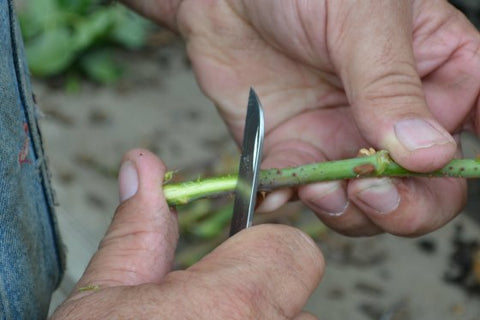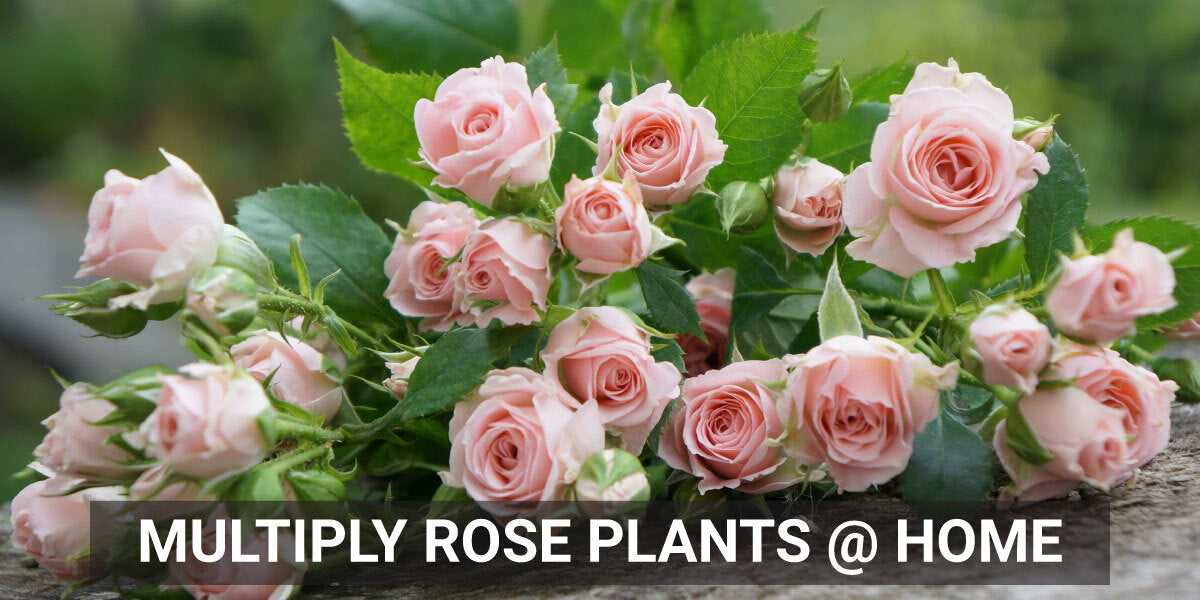How to Grow
How to grow rose plants from cuttings
Rose, the name itself is as beautiful as the flower. Every plant lover wants one of the rose plants in their garden. Being a queen of flowers, the rose plant is very easy to multiply its number with a simple method. Who does not want these crush flowers in their home in more numbers? Yes, every green thumb likes to have more and more number of these queens in their garden. Here you will get brief information regarding how to multiply rose plants easily at home like a pro gardener.

Rose has hundreds of species and varieties. Botanically rose is Rosa spp. And belongs to the family Rosaceae. This shrub can be propagated in different ways like seeds, cuttings, layering, and grafting. Here I will let you know about how to propagate rose plants by cuttings.
Tools and materials required:
a. Mother plant/ matured rose plant
- Select well grown robust plant to obtain cuttings from them
b. Pruning scissors
- Sharp scissors are important to give a slant cut to mother plant and to take cuttings without damaging the main plant
c. Garden tool sterilizer
- You can use any disinfectant to wash tools before pruning operation
d. Rooting hormone
- After taking out the cuttings you have to apply rooting hormone at the end of the cuttings to induce roots, when you plant it in soil.
e. Good quality potting mix
- Potting mix takes an important role in rooting of the cuttings as compact soil may not help cuttings to root well.
f. Rose cuttings
- Select 6-8" long cuttings of pencil size thick.
10 simple steps to propagate rose plants in your home:
- Best season: Rose roots all round the year, but do best in summer and fall seasons.
- Selection of vigor cuttings: Select the stem of the plant, which has recently bloomed i.e. When flowers are matured and petals are falling off. Because it will have all the vigor to root well in the soil.

- Length of the cuttings: Flower heads or tips should be removed down to the first pair of healthy leaves. Cuttings should be 6-8’’ in length. Make a clean cut with sharp cutters. Make a cut at an angle of 45 degrees. (Pruning scissor)

- Favorable condition: In the hot summer, you have to mist over cuttings, to retain the moisture content in cuttings. Make sure not to dry out the cuttings.( Mist nozzle)
- Process of propagation: Take 6-8’’ long cutting, remove all the leaves except one pair of leaves on the top. Scrape the bark at the lower end of the cuttings. Do not cut into the wood, just scrape the bark. Apply some rooting hormone on the scraped surface. That is the place where exactly root development starts.

-
Planting: you can plant the cuttings by leaving 2-3 buds above the ground and 1-2 buds inside the soil. Leave one set of healthy leaves on the bud. Leaving some leaves helps to produce food by photosynthesis and provide energy for rooting. Potting media should be loose, well draining, and rich in all the essential nutrients. ( Potting mix, Perlite, Vermiculite )

- Watering: Your propagating media should be wet but not soggy/waterlogged. Try not to over water or underwater the cuttings.
- Light: keep your ready cuttings under bright indirect light, but not under direct sunlight. Periodic misting is much needed to prevent drying out of the rose cuttings. It also improves the rooting of the cuttings.
- Mini greenhouse: You can create greenhouse condition by covering the rose cuttings with water bottle, mind to open the lid (as shown in the figure). Or you can go for covering your cuttings with plastic covers by inserting 3-4 sticks around the cuttings. Do not let too much heat for your cuttings. Better to prevent drying of leaves of the cuttings. For this reason, you can check your mini greenhouse and mist it periodically.

- Rooting: Most of the rose cultivars will root in 10-15 days. Provided wet conditions in the soil media.

- Replanting: you can replant your cuttings into the main location after 20 – 25 days when there is a good root development.
Although it is easy to multiply the rose plants, it is important to take care of new plants those grown out of cuttings. Follow the above-mentioned care tips for your plants and be a pro gardener.
Top questions about rose plants:
1. How to prune back rose bushes?
It is not that difficult to prune rose bushes as you think. When cutting back, pruning or deadheading roses, always use clean, sharp pruning tools. Make cuts at a 45-degree angle just above a leaf set. Major cutting back of a rose bush should be done in late fall or early spring while the plant is dormant. Deadheading or cosmetic pruning can be done at any time, as needed. Roses will benefit from a good hard pruning once a year.
2. How and when do you fertilize a rose bush?
In spring, roses need to be fed with a high phosphorus fertilizer. Roses often require extra phosphorus, so treat them with bone meal in midsummer. Fertilizers that contain high nitrogen, the N in NPK, can cause roses to be green and leafy but not bloom properly. When fertilizing roses, try to find a rose food with a higher middle number, like 10-15-10. Spring is usually a good time to fertilize roses or you can also feed your roses with flower booster.
3.Why is my rose bush not blooming?
There can be many reasons a rose may not bloom. One cause could be too much nitrogen in the soil or fertilizer you are using. Nitrogen promotes lush, green foliage and can cause the plant to put all its energy into the foliage, but not the blooms. Fertilize roses with a fertilizer made specifically for roses for optimum health and growth. Less sunlight can also cause roses not to bloom. Roses need at least six hours of full sun each day. Insects or disease can also prevent blooming in rose bushes.
4. When and how to transplant roses?
If roses need to be transplanted, it should be done in early spring before they leaf out. When transplanting anything, pre-dig a large hole where the plant will be going before digging up the plant. This will reduce transplant shock and allow you to investigate the soil in the new site and make amendments if necessary. You can also mix up a batch of water and rooting fertilizer to help the rose plant adjust to its new home. It also helps if you prune back the rose to a height of about a foot; this will cause the plant to put more energy into rooting than leafing and budding. It also eliminates some of the thorns, which can make working with roses unpleasant.
5.Why are my rose bush leaves turning yellow ?
Yellowing foliage on roses is often a symptom of black spot or any other fungal disease. It may be necessary to cut back this yellow foliage and disposing it immediately to avoid spreading of the disease further. And then treat the whole rose plant with a fungicide like neem oil. Yellowing foliage can also be a sign of a nutrient deficiency. Usually, nitrogen keeps the foliage green and healthy. Nitrogen also gets leached out by repeated watering or frequent rains. If you suspect that your roses are deficient in nitrogen, add some organic manures like vermicompost/ biomanure. or spray the rose bushes with all purpose organic plant nutrients.
Popular Searches: Garden Accessories for Sale, Compost Bin India, Plastic Flower Pots Online, Contemporary Plant Pots, Hanging Pots Online, Colourful Plant Pots, Bird Feeders Online, Rectangular Planters Online, Small Pots Online, Flower Pots Online, Kitchen Waste Compost Bin, Balcony Railing Planter, Buy Pots Online, Indoor Plant Pots, Metal Flower Pot




Rooting hormone,please suggest and for budding any hormone required ? Name please
Very informative.
Thanks for your educational trips. Please be with me and giving such lessons.